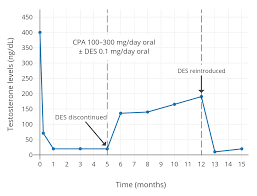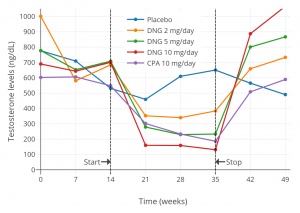What Are Normal Testosterone Levels For Men And Women Throughout Life?
What Are Normal Testosterone Levels for Men and Women Throughout Life?
Testosterone Levels are dependent upon a variety of diverse factors. Most logically, Testosterone is dependent upon gender, but it is also contingent on age, health, lifestyle, and genetics. Males almost always have more Testosterone than women unless influenced by external factors such as Hormone Therapy or Hormone Suppression.
Testosterone belongs to a collection of critical hormones known as Androgens. Androgen is the catch-all term for sex hormones associated with male function and form. Although Androgens are expressed in higher concentrations in men, women also produce Androgens like Testosterone at much lower levels.
levels.
The opposite is also true. Men need Estradiol and other Estrogens for normal function but produce far less of the feminine Hormones. The majority of Testosterone produced by a woman's body is transformed into Estradiol.
While the Adrenal glands produce small amounts of Testosterone for both men and women, the testes and ovaries are responsible for most of the Testosterone secretion.
What Does Testosterone Do for Men?
Testosterone is central to developing primary and secondary sex characteristics in men. It's responsible for the formation of the sex organs during fetal development and is responsible for spurring the maturation of the sex organs during puberty.
Testosterone also plays an essential role in libido, metabolism, strength, energy level support, and reproduction.
What Does Testosterone Do for Women?
For women, Testosterone encourages fertility and facilitates libido while promoting the creation of red blood cells and maintaining Hormone Homeostasis. Both sexes report issues with fertility and sex drive associated with Low Testosterone Levels.
What Are Healthy Testosterone Levels?
Testosterone is crucial, and the body thrives when Testosterone Levels are in the healthy range. While men and women can have naturally high Testosterone Production, Low-T is the far more prevalent condition, and most people have Testosterone circulating within the healthy range.
However, men and women are more prone to diminishing testosterone issues as they age. Testosterone is calculated using nanograms per deciliter by most physicians. Testosterone Levels are assessed via blood samples.
Abnormally Low Testosterone Levels during gestation can interfere with male fetal development. Suppressed Testosterone Levels during adolescence can delay or slow pubertal development. High Testosterone in boys can trigger early puberty.
Normal Testosterone Levels by Age
Early Development In Boys In Girls
0-5 Months Years 75-400 ng/dl 20-80 ng/dl
6 Months-9 Years Less than 20 ng/dl Less than 20 ng/dl
10-11 Years Less than 130 ng/dl Less than 44 ng/dl
During Puberty In Boys In Girls
12-13 Years Less than 800 ng/dl Less than 75 ng/dl
14 Years Less than 1200 ng/dl Less than 75 ng/dl
15-16Years 100-1200 ng/dl Less than 75 ng/dl
During Adulthood In Men In Women
17-18 Years 300-1200 ng/dl 20-75 ng/dl
19+ Years 240-950 ng/dl 8-60 ng/dl
Tanner Scale for Measuring Adolescent Development
While the guidelines above are generally correct, many physicians evaluate Testosterone Levels in children and adolescents according to the visual phase of development. To do this, doctors refer to a clinical schema known as the Tanner Scale. This scale is helpful because children reach puberty and mature at different rates.
Stage I on the Tanner Scale is associated with the period before puberty, and Stage II is reached when visible signs of puberty first appear. The following provides information regarding the Testosterone Levels related to Tanner Stage in both boys and girls:
Tanner Stage In Boys In Girls
Stage I Less than 20 ng/dl Less than 20 ng/dl
Stage II 8-66 ng/dl Less than 47 ng/dl
Stage III 26-800 ng/dl 17-75 ng/dl
Stage IV 85-1,200 ng/dl 20-75 ng/dl
Stage V 300-950 ng/dl 12-60 ng/dl
What Are the Symptoms of Testosterone Deficiency in Men?
Low Sex Drive
Thin, Easily Damaged Skin
Issues with Concentration and Memory
Fatigue
Thinning Hair on Head, Face, and Body
Weight Gain
Depression and Anxiety
What Are the Symptoms of Testosterone Deficiency in Women?
Low Fertility
Osteopenia/Osteoporosis
Low Libido
Missed or Irregular Periods
Sexual Lubrication Issues
Polycystic Ovary Syndrome and Testosterone Levels
Polycystic Ovary Syndrome is one of the women's most common reasons for excessive testosterone. Women struggling with PCOS experience elevated Testosterone Levels, which can lead to issues such as facial and body hair development, acne, oily skin, and absent or irregular periods.
Steroid Use and Testosterone Levels
Steroids are anabolic organic compounds that share similarities with Testosterone. Steroids are commonly used to increase body mass and build muscle. They are often utilized illicitly by men and women looking to bulk up.
Steroid use and abuse can have a dramatic effect on natural Testosterone Production.
When guys abuse steroids, it can cause Testosterone Levels to drop precipitously, leading to low libido, temporary infertility, increased body/facial hair, acne, and testicular shrinkage.
In women, Steroid abuse can disrupt fertility and period timing while also causing baldness, acne, unfortunate hair growth, and deepening of the voice.
Testing for Testosterone-Related Issues in Men and Women
If an individual believes they are having issues related to Low-T or Elevated Testosterone Levels, they should strongly consider reaching out to a doctor or Hormone Specialist for evaluation.
When evaluating Testosterone Abnormalities, it is common for physicians to follow some general guidelines. For example, opiates dramatically affect the body's ability to produce Testosterone, so they will likely ask about prior opiate use and the use of steroids.
Men will often be measured for waist circumference, BMI, prostate/testicle size, and evaluated for signs of baldness. Women will be assessed for masculation symptoms and acne, and menstrual function.
masculation symptoms and acne, and menstrual function.
How Are Testosterone Levels Tested?
Free and Total Testosterone Levels are evaluated using a blood test. To provide the most accurate results, Serum Testosterone is best tested during the morning hours, which gives the doctor the best idea regarding your peak Testosterone Production.
The established Low-T Threshold for men varies depending upon the source, but most medical professionals consider Testosterone Deficiency associated with Testosterone Production lower than 230-350 ng/dl. Healthy women should have Testosterone Levels registering at 15-75 ng/dl.
- 0001 Top Tips For Boosting Testosterone Naturally [Last Updated On: September 27th, 2025] [Originally Added On: May 27th, 2020]
- 0002 The Testosterone Factor [Last Updated On: October 28th, 2025] [Originally Added On: May 28th, 2020]
- 0003 Testosterone Can Help Relieve The Menopause Symptom Of Hot Flashes [Last Updated On: February 14th, 2025] [Originally Added On: May 29th, 2020]
- 0004 How Does Low Testosterone Cause Infertility? [Last Updated On: February 8th, 2025] [Originally Added On: May 30th, 2020]
- 0005 The Benefits Of Testosterone Therapy For Prostate Cancer [Last Updated On: February 14th, 2025] [Originally Added On: May 31st, 2020]
- 0006 Is Testosterone Replacement A Valid Diabetes Treatment? [Last Updated On: February 15th, 2025] [Originally Added On: June 1st, 2020]
- 0007 Testosterone Shock Therapy May Be An Effective Prostate Cancer Treatment [Last Updated On: February 5th, 2025] [Originally Added On: June 2nd, 2020]
- 0008 Testosterone Replacement Therapy Is Safe For The Heart [Last Updated On: February 14th, 2025] [Originally Added On: June 3rd, 2020]
- 0009 Testosterone Replacement Therapy [Last Updated On: October 22nd, 2025] [Originally Added On: June 4th, 2020]
- 0010 Testosterone Patches [Last Updated On: February 8th, 2025] [Originally Added On: June 5th, 2020]
- 0011 Testosterone Overview [Last Updated On: February 13th, 2025] [Originally Added On: June 6th, 2020]
- 0012 Testosterone Levels And Making Money [Last Updated On: September 10th, 2025] [Originally Added On: June 7th, 2020]
- 0013 Testosterone Enanthate [Last Updated On: September 9th, 2025] [Originally Added On: June 8th, 2020]
- 0014 Increased Awareness Of Low-t Helps Men Live Healthier Lives [Last Updated On: February 7th, 2025] [Originally Added On: June 9th, 2020]
- 0015 How Does Low-t Lead To Erectile Dysfunction? [Last Updated On: February 7th, 2025] [Originally Added On: June 10th, 2020]
- 0016 Testosterone Basics [Last Updated On: February 6th, 2025] [Originally Added On: June 11th, 2020]
- 0017 How Does Testosterone Impact Prostate Health? [Last Updated On: February 6th, 2025] [Originally Added On: June 12th, 2020]
- 0018 Testosterone And Other Sex Hormones Impact Asthma Response Dependent On Sex [Last Updated On: February 5th, 2025] [Originally Added On: June 13th, 2020]
- 0019 Recognizing Subtle Symptoms Of Testosterone Deficiency [Last Updated On: February 4th, 2025] [Originally Added On: June 15th, 2020]
- 0020 Testosterone Trivia [Last Updated On: February 4th, 2025] [Originally Added On: June 16th, 2020]
- 0021 The Health Benefits Of Testosterone And Sleep Are Interconnected [Last Updated On: February 3rd, 2025] [Originally Added On: June 17th, 2020]
- 0022 How Can I Restore My Testosterone Production Naturally? [Last Updated On: September 4th, 2025] [Originally Added On: June 18th, 2020]
- 0023 Low-t Quiz [Last Updated On: September 3rd, 2025] [Originally Added On: June 19th, 2020]
- 0024 Low Testosterone Might Mean Poor Sleep Need Testosterone Hormone Injections [Last Updated On: September 2nd, 2025] [Originally Added On: June 20th, 2020]
- 0025 Low Testosterone Contributes To Frailty With Age [Last Updated On: September 1st, 2025] [Originally Added On: June 21st, 2020]
- 0026 Low Testosterone Affects A Third Of Young Men With Type 2 Diabetes [Last Updated On: August 31st, 2025] [Originally Added On: June 22nd, 2020]
- 0027 Japanese Testosterone Study Proves Physical And Psychological Benefits [Last Updated On: August 30th, 2025] [Originally Added On: June 23rd, 2020]
- 0028 Intramuscular Injections Are Safer Procedures [Last Updated On: August 29th, 2025] [Originally Added On: June 24th, 2020]
- 0029 Injecting Testosterone (im) [Last Updated On: October 24th, 2025] [Originally Added On: June 25th, 2020]
- 0030 Injectable Testosterone And Testosterone Cream [Last Updated On: February 14th, 2025] [Originally Added On: June 26th, 2020]
- 0031 Indiana Jones Vs. Rambo (hgh Testosterone) [Last Updated On: August 28th, 2025] [Originally Added On: June 27th, 2020]
- 0032 How Much Does Testosterone Control Men's Behavior? [Last Updated On: August 27th, 2025] [Originally Added On: June 28th, 2020]
- 0033 Getting To The Bottom Of Low-t Under-reported Sources Of Testosterone Deficiency [Last Updated On: February 14th, 2025] [Originally Added On: June 29th, 2020]
- 0034 How To Manage And Overcome Testosterone Deficiency [Last Updated On: August 26th, 2025] [Originally Added On: June 30th, 2020]
- 0035 Clomiphene Low-testosterone Andropause Treatment [Last Updated On: February 3rd, 2025] [Originally Added On: July 1st, 2020]
- 0036 How Do Synthetic Chemicals Impact Testosterone Secretion? [Last Updated On: August 18th, 2025] [Originally Added On: July 2nd, 2020]
- 0037 Interest In Bio-identical Testosterone Is Skyrocketing [Last Updated On: August 25th, 2025] [Originally Added On: July 3rd, 2020]
- 0038 Axiron Spray-application Testosterone Replacement Therapy [Last Updated On: August 24th, 2025] [Originally Added On: July 4th, 2020]
- 0039 Andropause: Male Menopause [Last Updated On: September 14th, 2025] [Originally Added On: July 5th, 2020]
- 0040 Testosterone Deficiency Treatment Options [Last Updated On: August 21st, 2025] [Originally Added On: July 6th, 2020]
- 0041 The Facts About Testosterone Hrt For Low-t [Last Updated On: August 22nd, 2025] [Originally Added On: July 7th, 2020]
- 0042 Misconceptions About Testosterone Replacement Therapy [Last Updated On: August 23rd, 2025] [Originally Added On: July 8th, 2020]
- 0043 Testosterone Replacement Therapy Facts And Myths [Last Updated On: October 4th, 2025] [Originally Added On: July 9th, 2020]
- 0044 Testosterone Injections For Testosterone Deficiency [Last Updated On: September 18th, 2022] [Originally Added On: July 10th, 2020]
- 0045 Testosterone Replacement Therapy May Help Aging Males Prevent Diabetes [Last Updated On: August 19th, 2025] [Originally Added On: July 11th, 2020]
- 0046 The Benefits Of Testosterone Replacement Therapy For Women [Last Updated On: August 17th, 2025] [Originally Added On: July 13th, 2020]
- 0047 How Can Testosterone Hrt Improve My Life Via Quality Low-t Treatments [Last Updated On: September 13th, 2025] [Originally Added On: July 14th, 2020]
- 0048 Frequently Asked Questions About Testosterone [Last Updated On: August 20th, 2025] [Originally Added On: July 15th, 2020]
- 0049 Bio-identical Testosterone Cypionate Injections [Last Updated On: August 16th, 2025] [Originally Added On: July 16th, 2020]
- 0050 All About Testosterone Creams [Last Updated On: August 13th, 2025] [Originally Added On: July 17th, 2020]
- 0051 Low Testosterone Treatment Protocols [Last Updated On: April 1st, 2025] [Originally Added On: July 19th, 2020]
- 0052 Testosterone Deficiency Drains Your Energy [Last Updated On: February 13th, 2025] [Originally Added On: July 21st, 2020]
- 0053 What Is Testosterone? [Last Updated On: August 11th, 2025] [Originally Added On: July 23rd, 2020]
- 0054 Eleven Signs Of Testosterone Deficiency [Last Updated On: March 30th, 2025] [Originally Added On: July 26th, 2020]
- 0055 Hypertension-Associated Cardiovascular Risks Increase Due To Both Low-T And High Testosterone [Last Updated On: February 18th, 2025] [Originally Added On: April 22nd, 2021]
- 0056 Everything to Know About Androgel [Last Updated On: March 27th, 2025] [Originally Added On: July 8th, 2021]
- 0057 Kinds of Testosterone Therapy – Which Is Right for You? [Last Updated On: March 21st, 2025] [Originally Added On: August 28th, 2021]
- 0058 This Study Says High Protein Diet May Suppress Testosterone Levels [Last Updated On: February 20th, 2025] [Originally Added On: March 28th, 2022]
- 0059 Testosterone and Estrogen Deficiency Associated With Increased Risk of Rotator Cuff Surgery [Last Updated On: February 14th, 2025] [Originally Added On: April 26th, 2022]
- 0060 Low Testosterone Accelerates Aging [Last Updated On: March 20th, 2025] [Originally Added On: May 3rd, 2022]
- 0061 Low Testosterone Endangers Your Health [Last Updated On: February 14th, 2025] [Originally Added On: May 14th, 2022]
- 0062 Testosterone Helps Modulate Immune Activity in the Digestive System [Last Updated On: February 14th, 2025] [Originally Added On: May 18th, 2022]
- 0063 Did you know: Testosterone treats depression! [Last Updated On: November 6th, 2025] [Originally Added On: May 19th, 2022]
- 0064 Benefits of Fenugreek – Boost Testosterone and More [Last Updated On: February 14th, 2025] [Originally Added On: May 23rd, 2022]
- 0065 Testicle Tanning: What is Tucker Carlson Talking About? [Last Updated On: April 16th, 2025] [Originally Added On: June 3rd, 2022]
- 0066 Using Testosterone to Combat Memory Issues in Diabetics [Last Updated On: February 14th, 2025] [Originally Added On: August 16th, 2022]
- 0067 About 40% of Men Have Low-T – and it Doubles the Risk of Severe COVID [Last Updated On: February 25th, 2025] [Originally Added On: September 21st, 2022]
- 0068 The Foods To Boost Your Testosterone…And The Foods To Avoid [Last Updated On: November 4th, 2025] [Originally Added On: September 30th, 2022]
- 0069 Tlando Testosterone: An Innovative Oral Therapy for Low-T [Last Updated On: November 3rd, 2025] [Originally Added On: October 1st, 2022]
- 0070 Testosterone Replacement Therapy (TRT) Explained [Last Updated On: April 8th, 2025] [Originally Added On: October 12th, 2022]
- 0071 Examining The Link Between Testosterone and Employability [Last Updated On: February 18th, 2025] [Originally Added On: November 8th, 2022]
- 0072 Standard Measure of Low Testosterone Doesn't Apply to Young Men [Last Updated On: March 12th, 2025] [Originally Added On: November 8th, 2022]
- 0073 Surprising Things that Cause Men’s Crashing Testosterone [Last Updated On: March 17th, 2025] [Originally Added On: January 5th, 2023]
- 0074 Understanding the Correlation between Testosterone Levels and Job Performance [Last Updated On: February 9th, 2025] [Originally Added On: February 9th, 2025]
- 0075 Link between Low Testosterone and Severe COVID Symptoms in Men [Last Updated On: February 12th, 2025] [Originally Added On: February 12th, 2025]
- 0076 The Good Job Grip: Is Testosterone the Key? [Last Updated On: February 13th, 2025] [Originally Added On: February 13th, 2025]
- 0077 Importance of Nutritional Balance in a Healthy Diet [Last Updated On: February 14th, 2025] [Originally Added On: February 14th, 2025]
- 0078 Invigorating Power of the Fenugreek Plant: A Natural Testosterone Energizer and More [Last Updated On: February 14th, 2025] [Originally Added On: February 14th, 2025]
- 0079 Unlocking the Testosterone Treasure: A Panacea for Cognitive Woes in Diabetic Patients [Last Updated On: February 14th, 2025] [Originally Added On: February 14th, 2025]
Word Count: 1011






